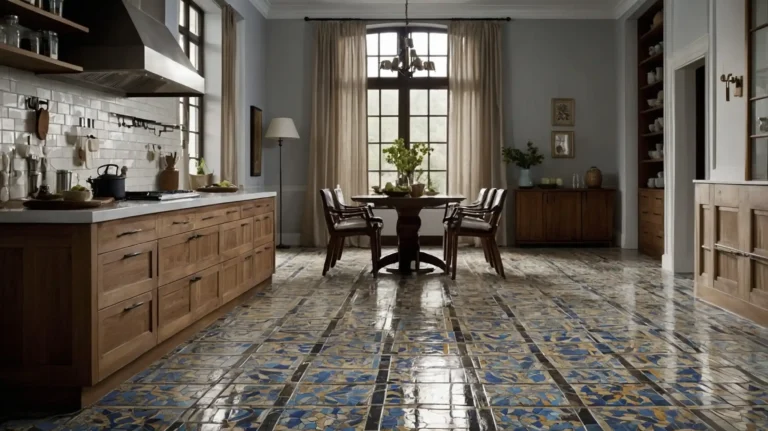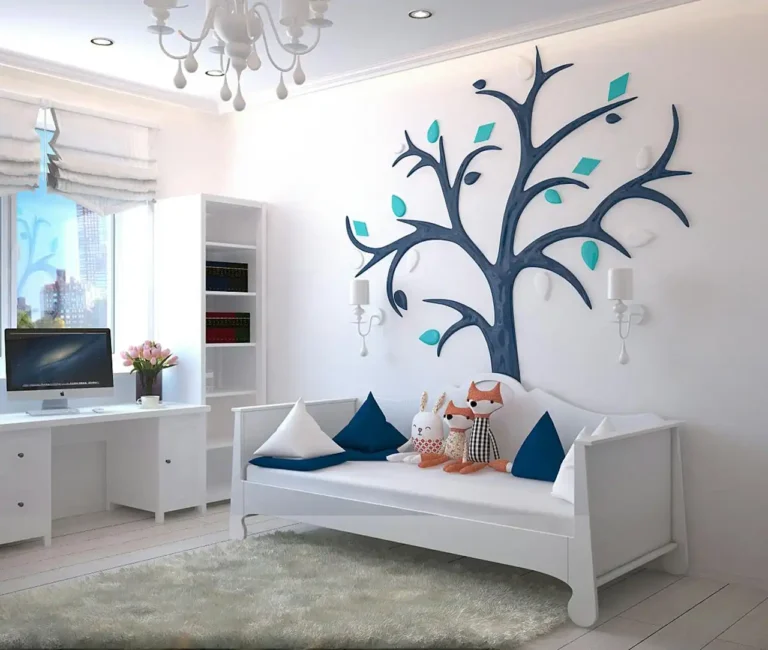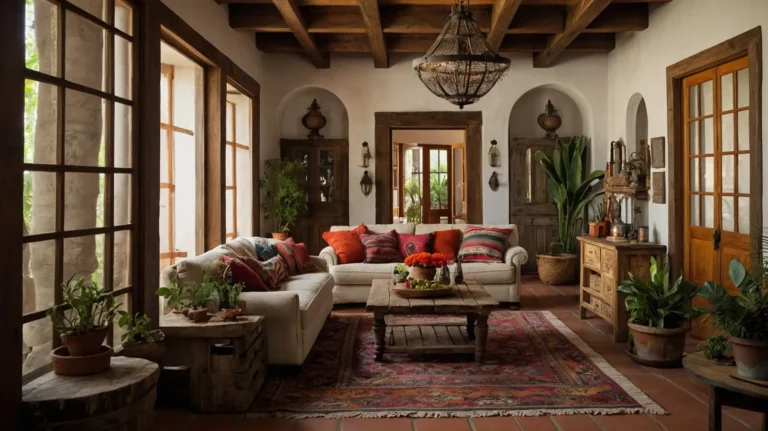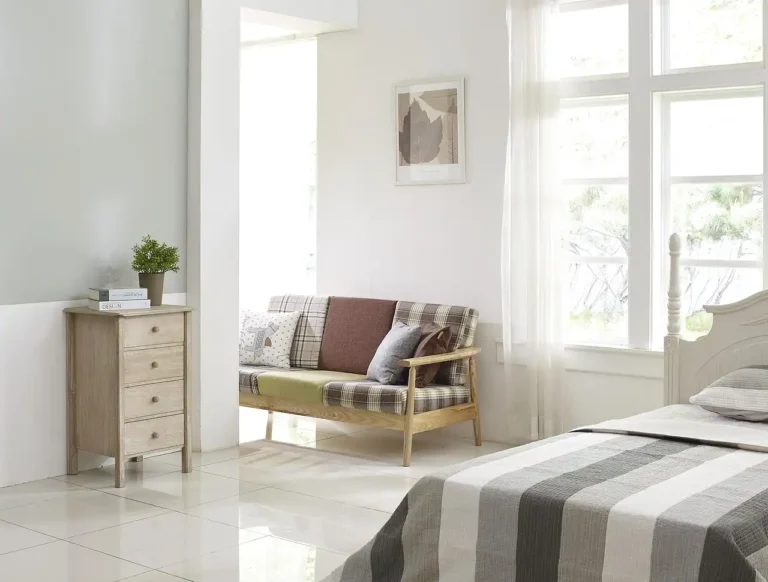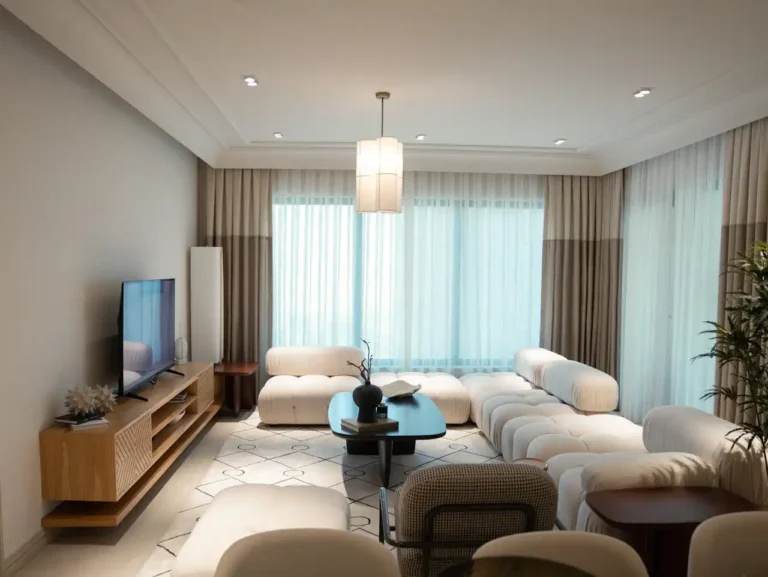27 Modern Front of House Lighting Ideas to Transform Your Home’s Curb Appeal
Your home’s exterior lighting serves multiple essential functions—enhancing security, improving safety, and creating a welcoming atmosphere for guests.
But beyond these practical aspects, thoughtful front-of-house lighting dramatically transforms your home’s appearance after dark.
Modern lighting options now offer unprecedented design flexibility, energy efficiency, and smart features.
With strategic placement and fixture selection, you can highlight architectural details, illuminate pathways, and create a distinctive nighttime presence.
Ready to elevate your home’s curb appeal after sunset?
These 27 innovative lighting ideas will help you create a front exterior that stands out in your neighborhood while perfectly complementing your home’s architectural style.
1: Install Linear Wall Sconces
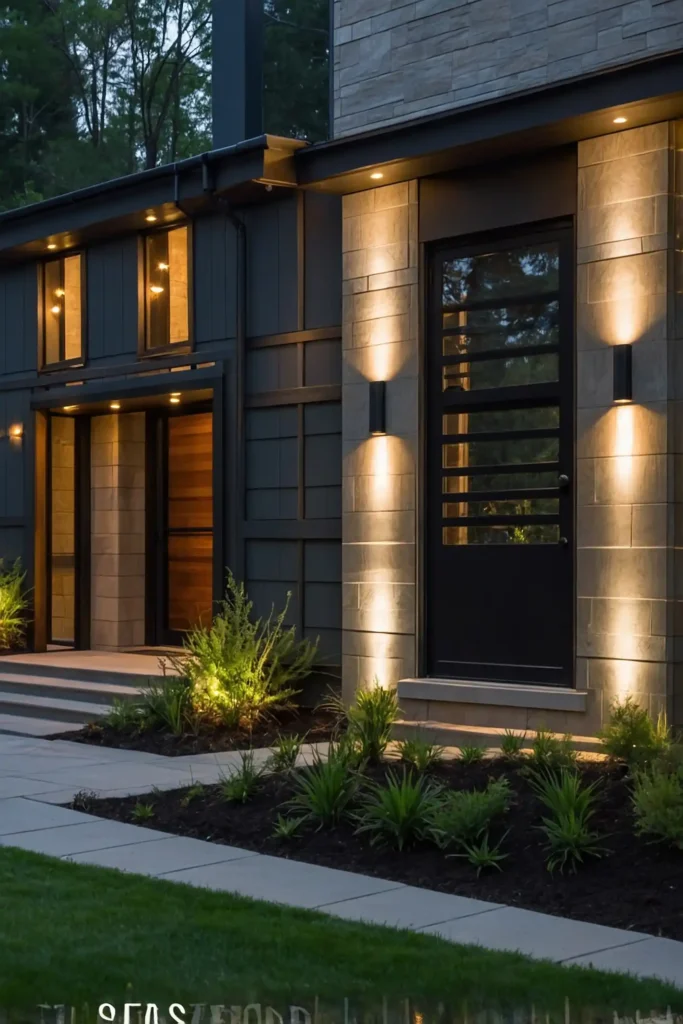
Mount sleek, elongated sconces on either side of your entry door for a contemporary statement.
These geometric fixtures create dramatic up/down light patterns that highlight your doorway.
You’ll appreciate how these modern alternatives to traditional lanterns provide ample illumination while making a strong design statement.
Choose black, brushed brass, or stainless finishes for different aesthetic effects.
Consider models with adjustable light direction to customize the illumination pattern on your façade.
2: Create Path Lighting with Hidden Sources
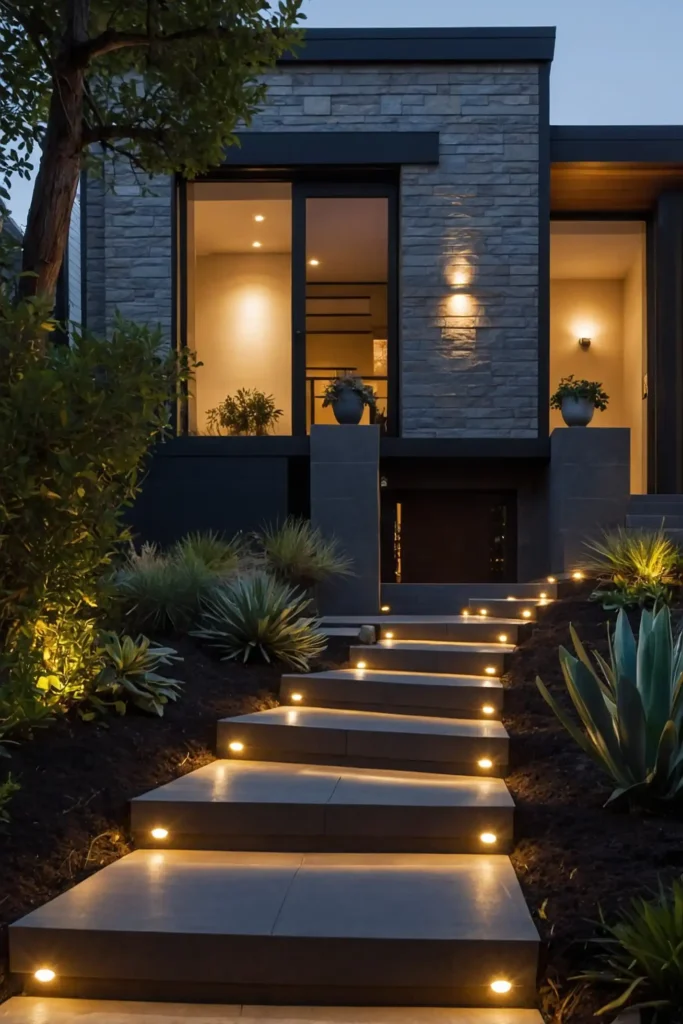
Illuminate walkways using fixtures that conceal the light source, creating the illusion of glowing surfaces rather than visible lamps.
Recessed step lights or under-step LED strips achieve this effect.
You’ll create a sophisticated, hospitality-inspired approach to wayfinding that guides visitors safely without visual clutter.
This technique works particularly well with contemporary architecture.
Program these lights on motion sensors or timers to activate only when needed for energy efficiency.
3: Install Oversized Statement Fixtures
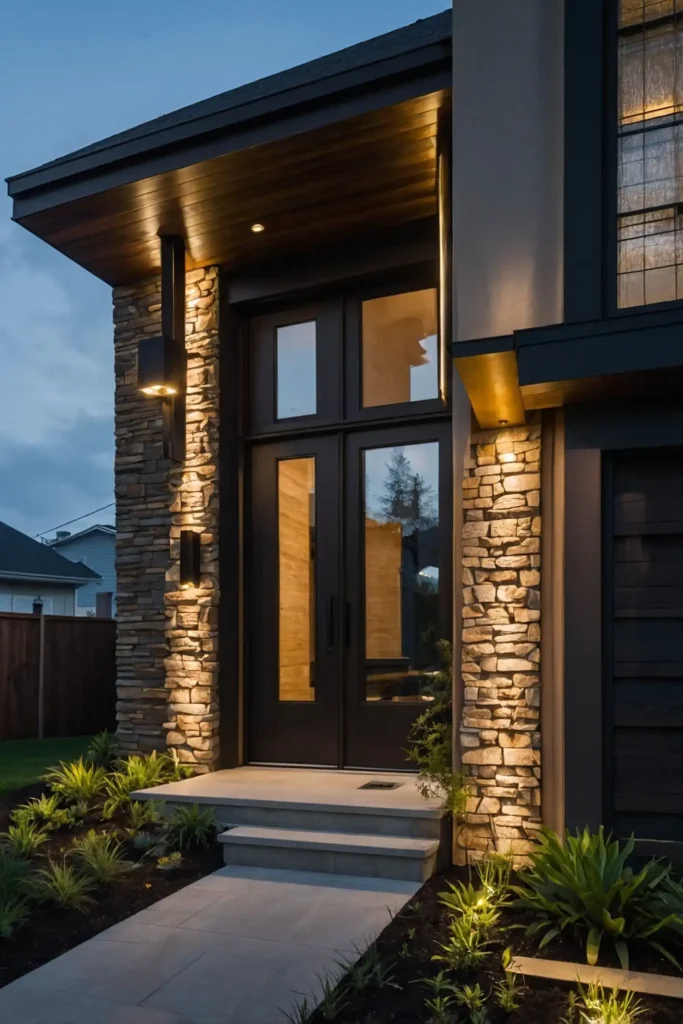
Make a bold first impression with dramatically scaled light fixtures that serve as sculptural elements by day and illumination sources by night.
Modern oversized pendants or wall-mounted fixtures create instant curb appeal.
You’ll establish a contemporary vibe while providing substantial illumination for entry areas.
Choose fixtures with interesting materials like perforated metal, frosted glass, or mixed textures.
Balance these statement pieces with simpler lighting elsewhere to avoid visual competition.
4: Implement Layered Landscape Lighting
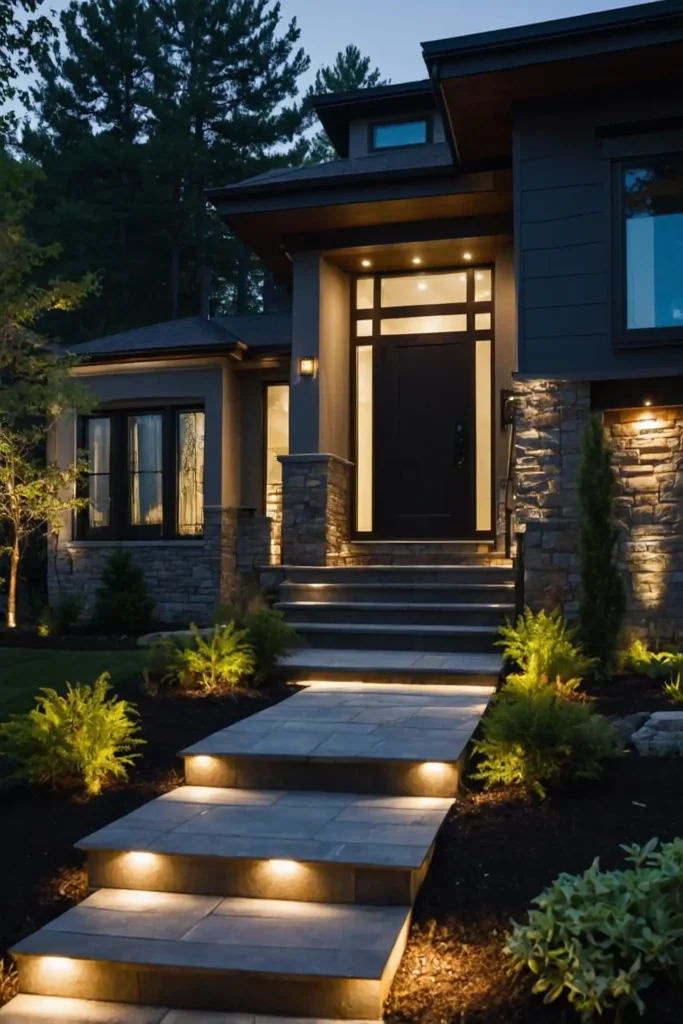
Create depth and dimension by illuminating your front yard with multiple lighting types—uplights for trees, downlights for pathways, and accent lights for architectural elements or garden features.
You’ll achieve a professional, resort-like appearance that highlights your landscaping’s best features while creating a welcoming approach to your home.
Use varied brightness levels to create visual hierarchy.
Consider color temperature carefully, with warmer tones (2700-3000K) creating a more inviting atmosphere than cooler options.
5: Add Linear LED Strip Lighting
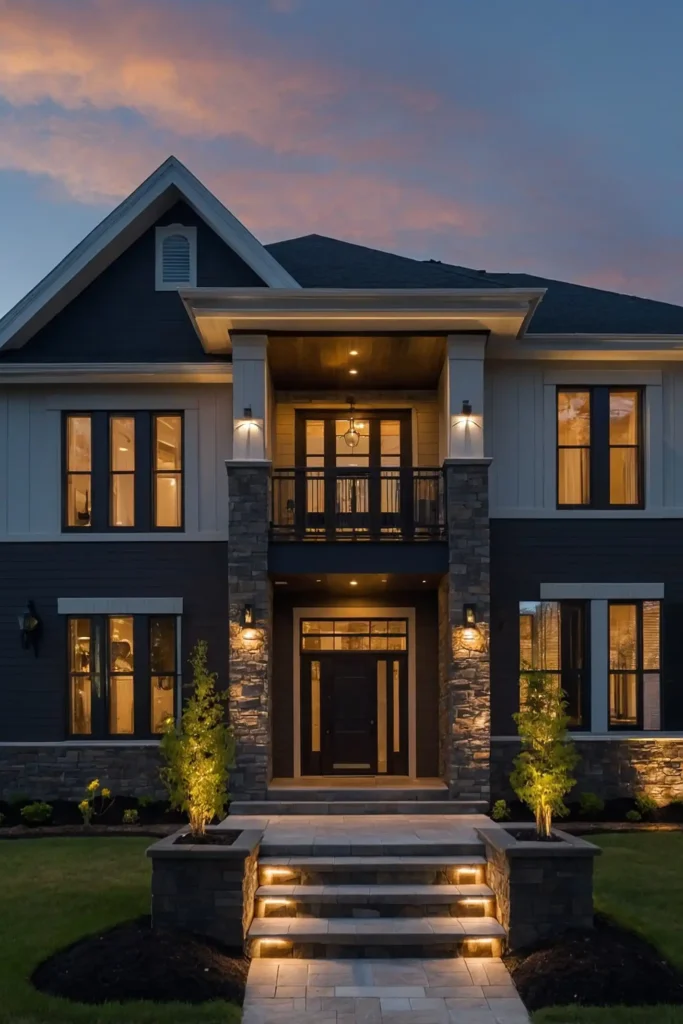
Outline architectural features like soffits, entryways, or steps with discrete LED strips that create glowing lines of light.
This contemporary approach emphasizes your home’s structure in a thoroughly modern way.
You’ll highlight interesting architectural details while creating a sophisticated nighttime presence.
Choose high-quality waterproof strips with consistent color rendering for best results.
Install with proper diffusers to eliminate visible “dots” of light for a smooth, continuous appearance.
6: Use Minimalist Bollard Lights
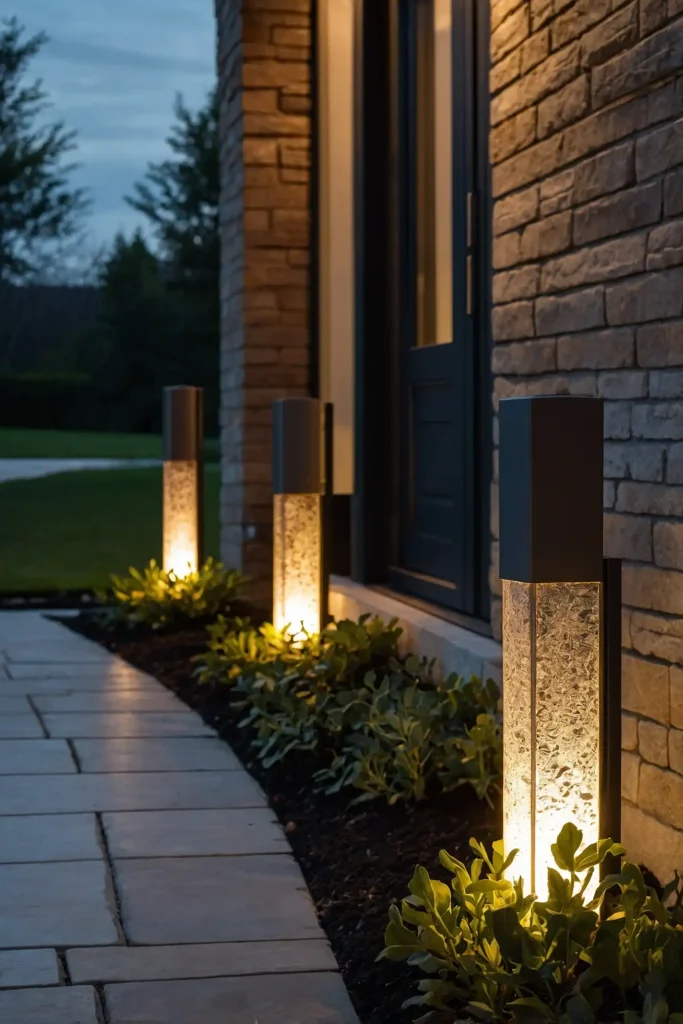
Line pathways with sleek, architectural bollard lights that provide directed downward illumination.
These contemporary fixtures guide visitors while maintaining a clean aesthetic.
You’ll appreciate their practical function and sculptural daytime presence.
Choose models with dark-sky friendly designs that prevent light pollution and direct illumination exactly where needed.
Space them at consistent intervals (typically 6-8 feet apart) for a cohesive, intentional appearance.
7: Incorporate Geometric Pendant Lighting
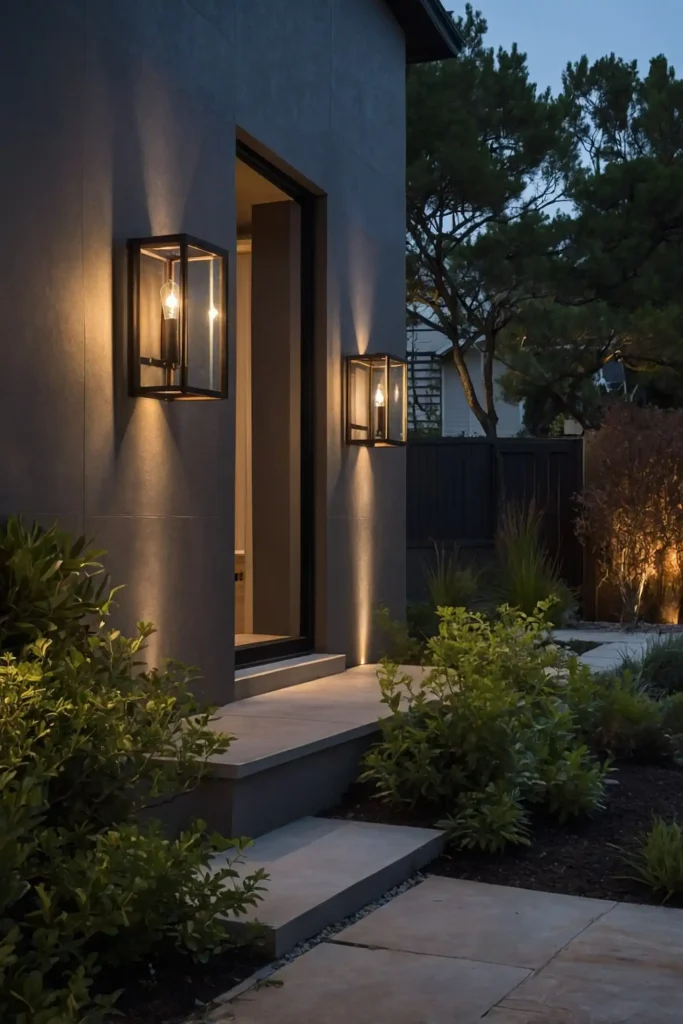
Hang distinctive geometric pendant lights in covered entry areas to create visual interest and set a contemporary tone.
These eye-catching fixtures serve as both functional lighting and artistic statements.
You’ll make a strong first impression while providing necessary illumination for your entry.
Consider scale carefully—larger pendants create drama while smaller clusters offer subtlety.
Choose materials that complement your home’s exterior finishes, from black metal to brass or copper that will develop a patina over time.
8: Install Subtle Ground-Recessed Uplights
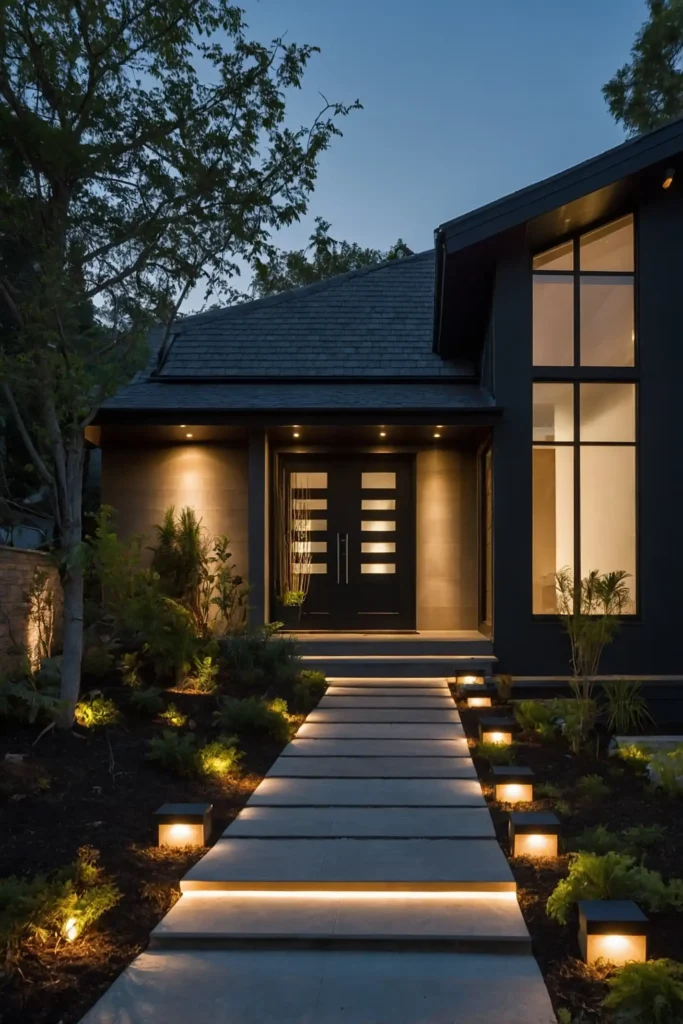
Illuminate façade features discretely with in-ground lights that wash exterior walls with light while hiding the fixtures themselves.
This technique highlights texture and creates dramatic shadows.
You’ll create sophisticated effects similar to high-end architectural lighting without visually cluttered fixtures.
Focus on specific elements like columns, unique materials, or architectural details.
Choose fixtures with adjustable beam spreads to control exactly how much area each light covers.
9: Add Offset Door Lighting
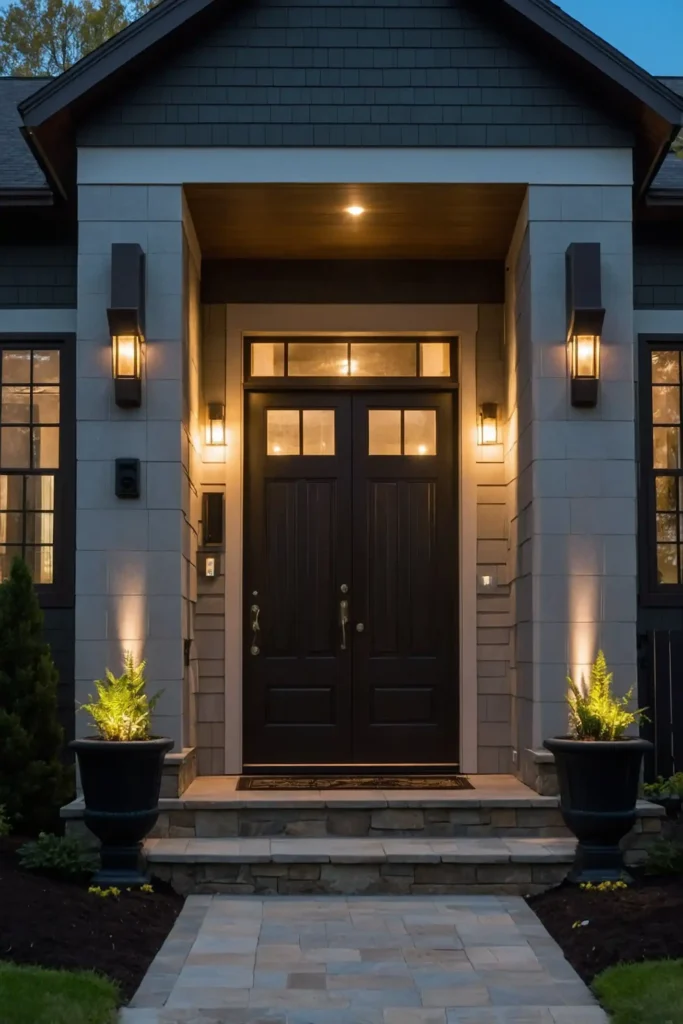
Replace traditional symmetrical doorway lighting with a single, oversized fixture mounted off-center for an unexpected contemporary twist.
This modern approach breaks conventional rules while maintaining functionality.
You’ll create visual interest and signal your design-forward aesthetic to visitors.
Balance this asymmetrical element with other design choices that help maintain overall façade harmony.
Choose a fixture with adequate brightness to properly illuminate your entire entry zone despite the single-sided placement.
10: Create Moonlighting Effects
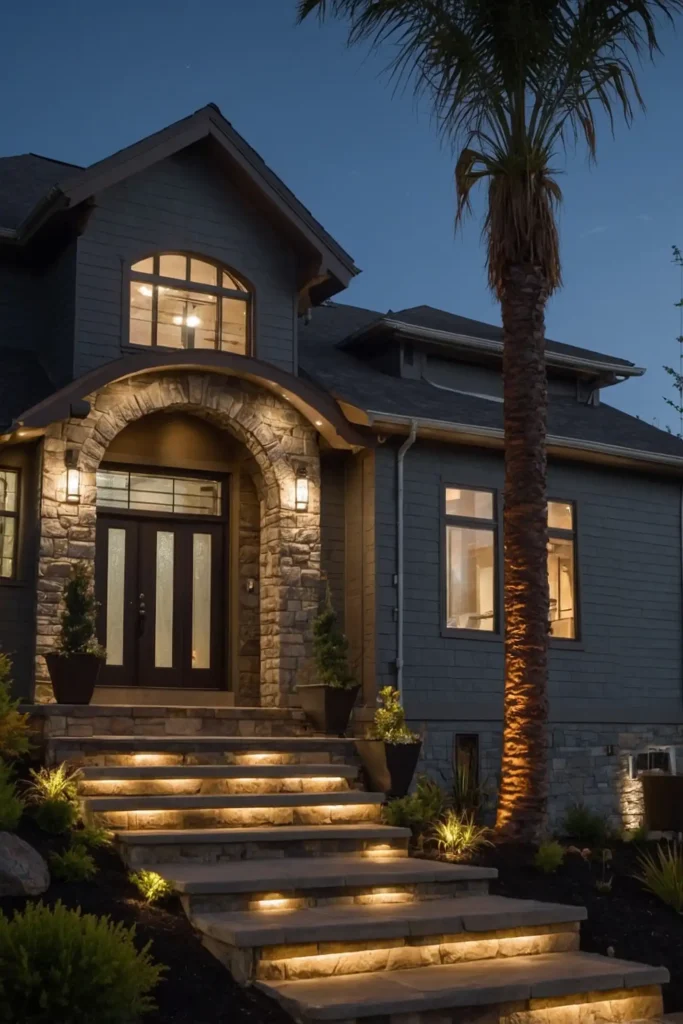
Install downlights high in mature trees to cast gentle, dappled illumination resembling natural moonlight across your front yard.
This subtle technique creates magical shadows and patterns.
You’ll achieve a natural, organic lighting effect that enhances landscaping without appearing artificial.
Position fixtures carefully to mimic the direction of actual moonlight for the most realistic effect.
Use fixtures with glare shields to prevent light trespass and keep the source hidden from view.
11: Incorporate Architectural Grazing Lights
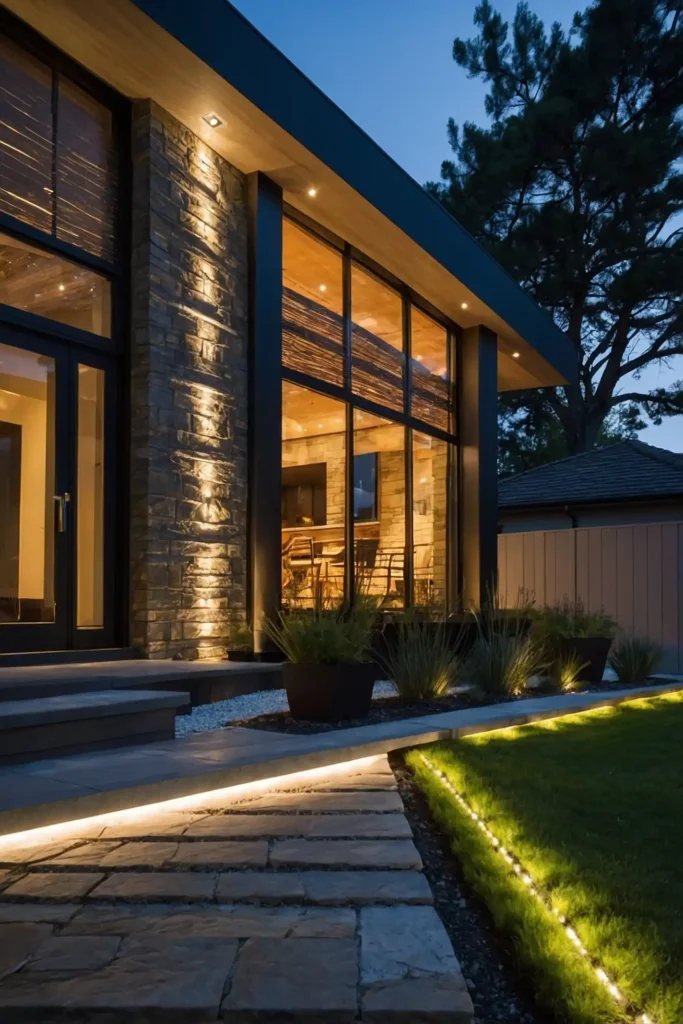
Position lights very close to textured exterior surfaces like stone, brick, or wood to “graze” the material with light, emphasizing texture through dramatic shadows.
This technique transforms flat-looking surfaces after dark.
You’ll highlight your home’s material qualities and craftsmanship through this sophisticated lighting approach.
Choose narrow-beam fixtures placed 12-18 inches from the wall for optimal effect.
Experiment with positioning—lower placement creates longer shadows and more drama than higher mounting.
12: Install Modern Address Lighting
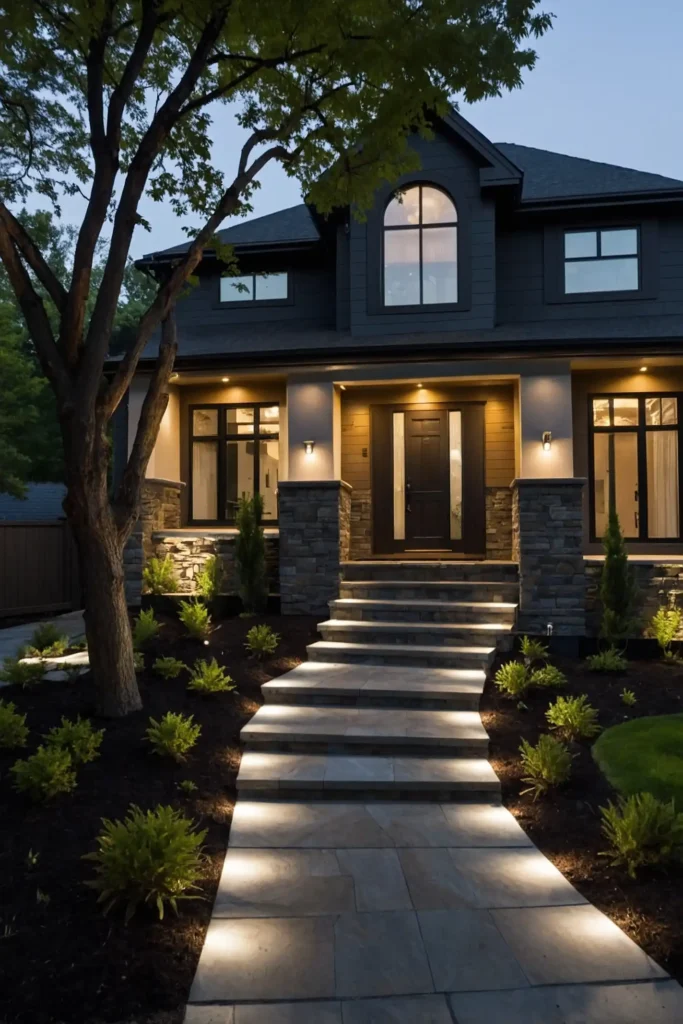
Replace standard house numbers with backlit or integrated LED address displays that combine functionality with contemporary style.
These illuminated numbers ensure visitors can find your home while adding a custom touch.
You’ll improve navigation to your property while adding an unexpected lighting element.
Consider custom metal fabrication with integrated lighting for a truly unique solution.
Choose energy-efficient LED options that will function reliably for years with minimal maintenance.
13: Use Flush-Mount Ceiling Lighting
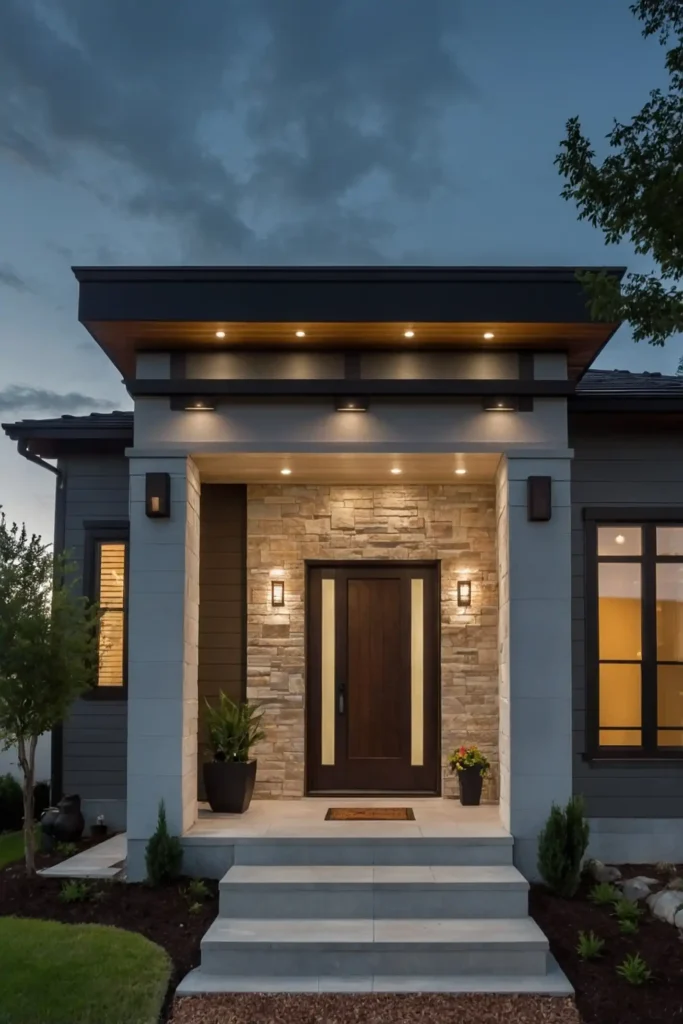
Update covered porches or entryways with sleek, low-profile ceiling fixtures that provide abundant illumination without visual bulk.
These contemporary alternatives to decorative hanging fixtures maintain clean sight lines.
You’ll create a modern, uncluttered appearance while ensuring proper illumination for safety and security.
Look for fixtures with integrated LED technology for the slimmest possible profile.
Consider models with color temperature adjustment to create different moods from energizing to relaxing.
14: Create Silhouette Lighting
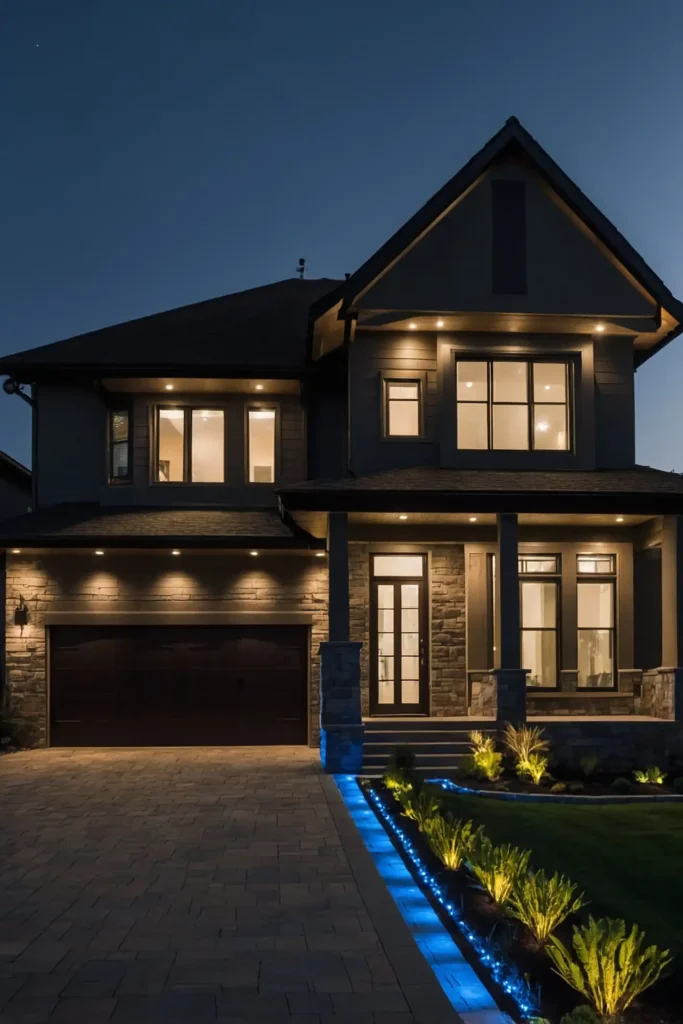
Position lights behind plants or architectural elements to create dramatic silhouettes against your home’s exterior walls.
This technique highlights interesting shapes while creating visual depth.
You’ll achieve an artistic lighting effect that transforms ordinary landscaping into compelling nighttime features.
Choose subjects with distinctive forms like sculptural plants, trees, or garden art.
Adjust fixture placement and brightness to control how pronounced the silhouette effect appears.
15: Install Smart RGB Lighting
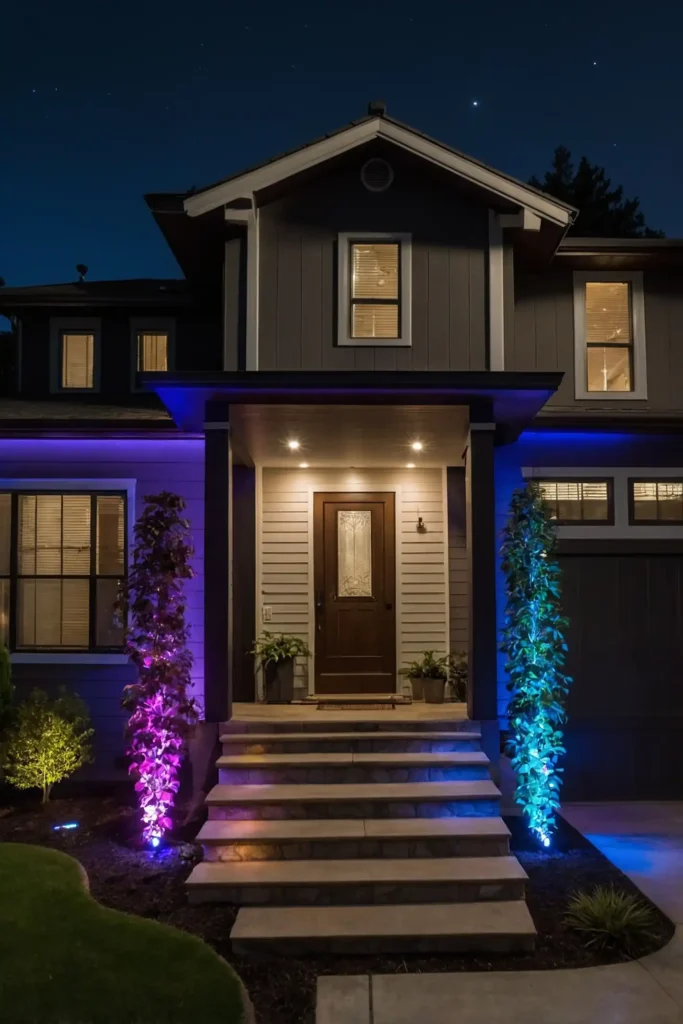
Incorporate color-changing RGB fixtures that allow you to customize your home’s appearance for different seasons, holidays, or events.
Modern smart lighting systems offer unprecedented flexibility.
You’ll enjoy the ability to transform your home’s appearance instantly through smartphone controls.
Use subtle color washes for everyday sophistication and more dramatic effects for special occasions.
Consider focusing RGB lighting on specific areas rather than the entire façade for a more refined approach.
16: Add Illuminated Planters
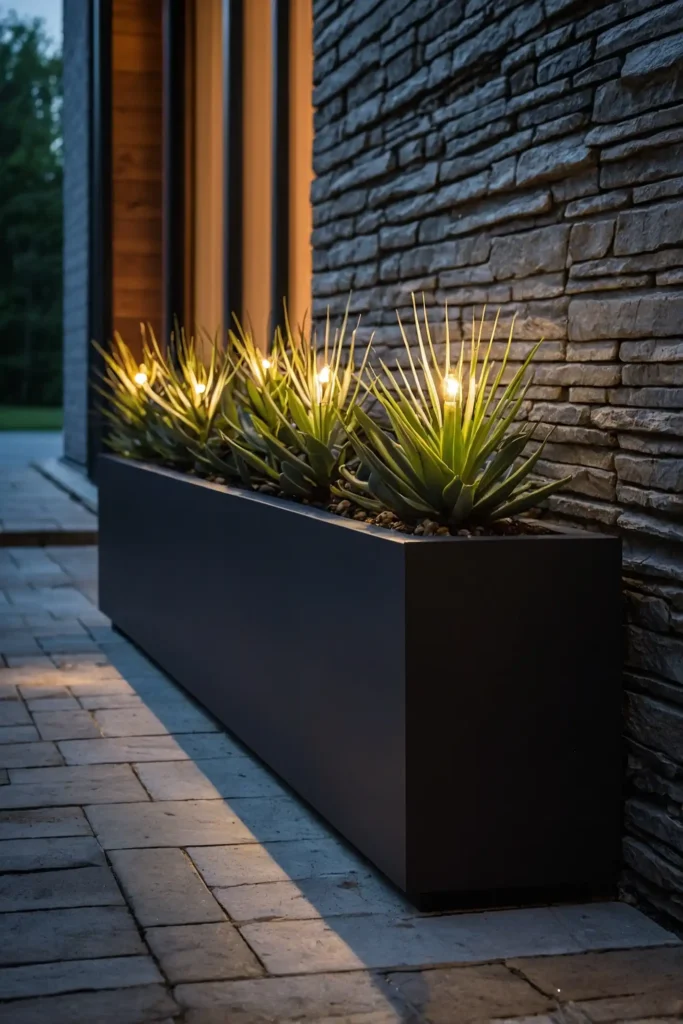
Place LED-integrated planters near your entry or along pathways to combine lighting and landscaping in one design element.
These multifunctional pieces create glowing focal points.
You’ll highlight your plants while adding ground-level illumination that guides visitors.
Choose containers with diffused lighting that creates a soft glow rather than harsh direct light.
Group different heights and sizes for visual interest while maintaining consistent light quality across all planters.
17: Create Shadow Play with Cutout Fixtures
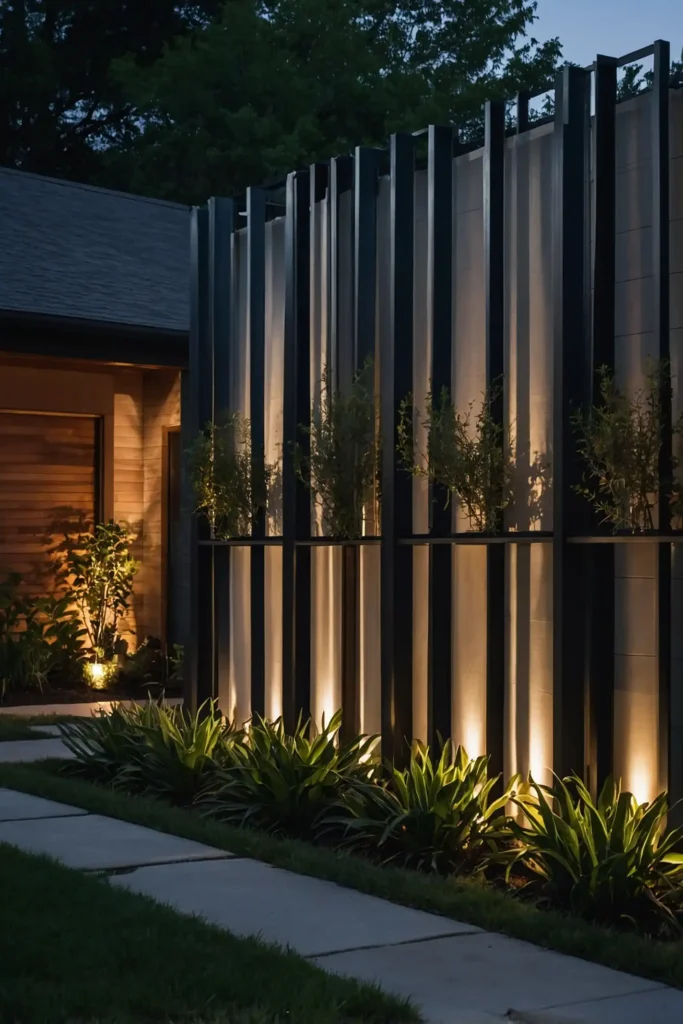
Install fixtures with decorative cutout patterns that cast intriguing shadows on your home’s exterior surfaces.
These artistic lights transform plain walls into dynamic canvases after dark.
You’ll add visual interest through the interplay of light and shadow, creating effects that change throughout the evening as the light angle shifts.
Choose patterns that complement your architectural style.
Position carefully to project onto flat, light-colored surfaces for maximum impact.
18: Use Indirect Soffit Lighting
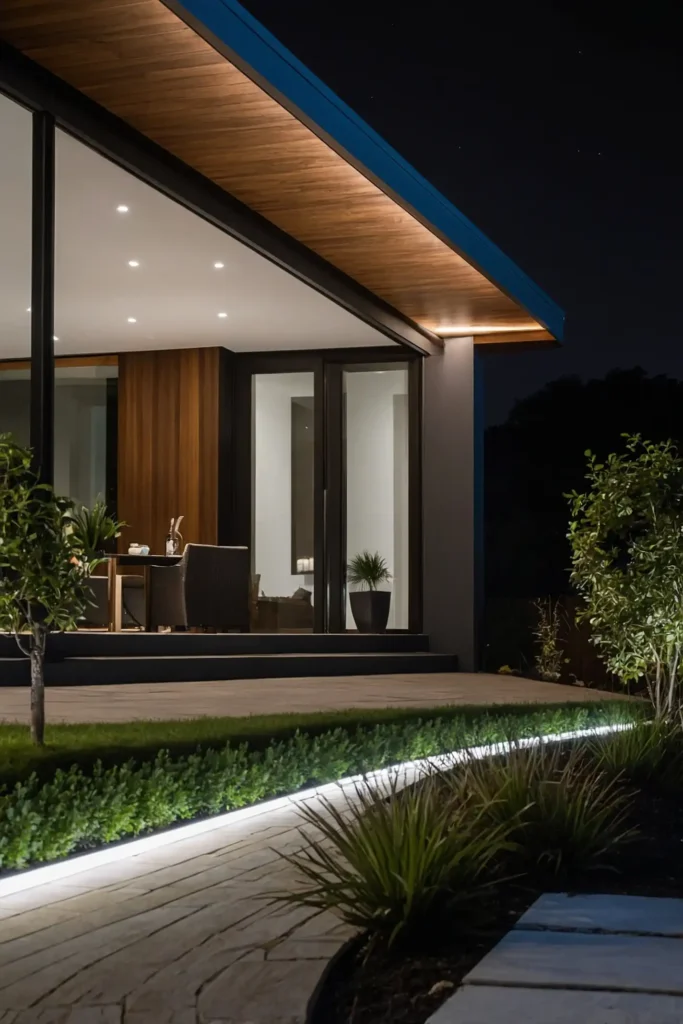
Conceal lights within soffits or overhangs to wash your home’s exterior walls with gentle illumination.
This technique eliminates visible fixtures while creating a sophisticated lighting effect.
You’ll achieve elegant illumination that highlights your home’s façade without glare or hotspots.
Position fixtures to create even light distribution without scalloping or obvious light source locations.
Select fixtures with beam spreads appropriate for your mounting height to ensure proper coverage.
19: Install Floating Step Lights
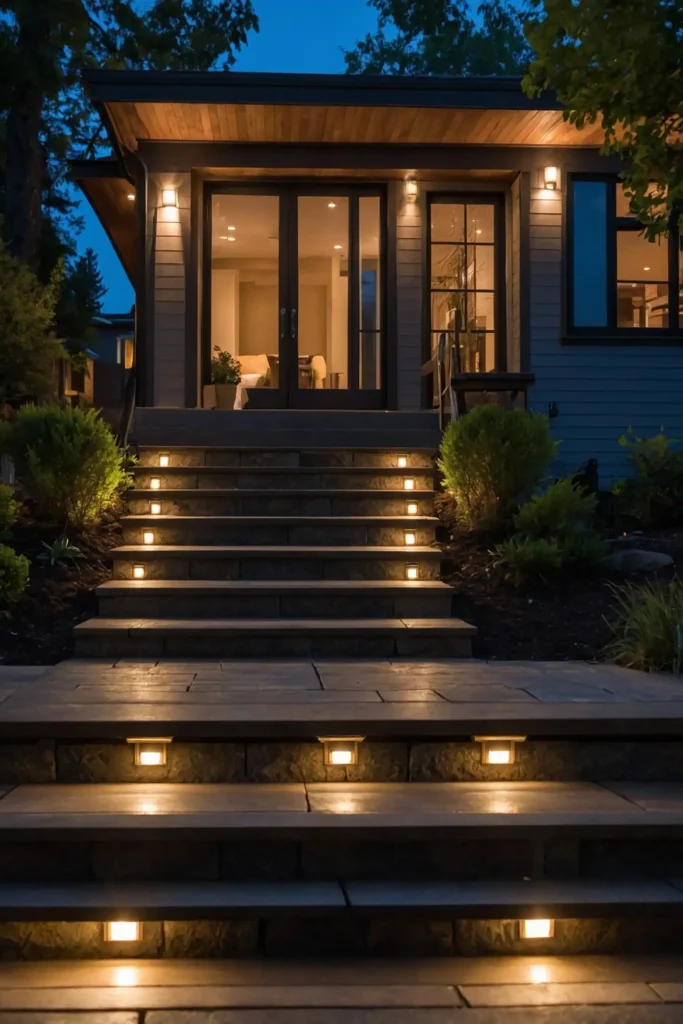
Illuminate outdoor staircases with fixtures that create the illusion of floating or hovering steps.
These contemporary lights enhance safety while adding architectural interest.
You’ll transform a functional element into a design feature while ensuring secure footing after dark.
Consider LED strips mounted underneath step overhangs for the most dramatic floating effect.
Ensure all connections are properly weatherproofed and suitable for outdoor installation.
20: Add Minimalist Spotlights
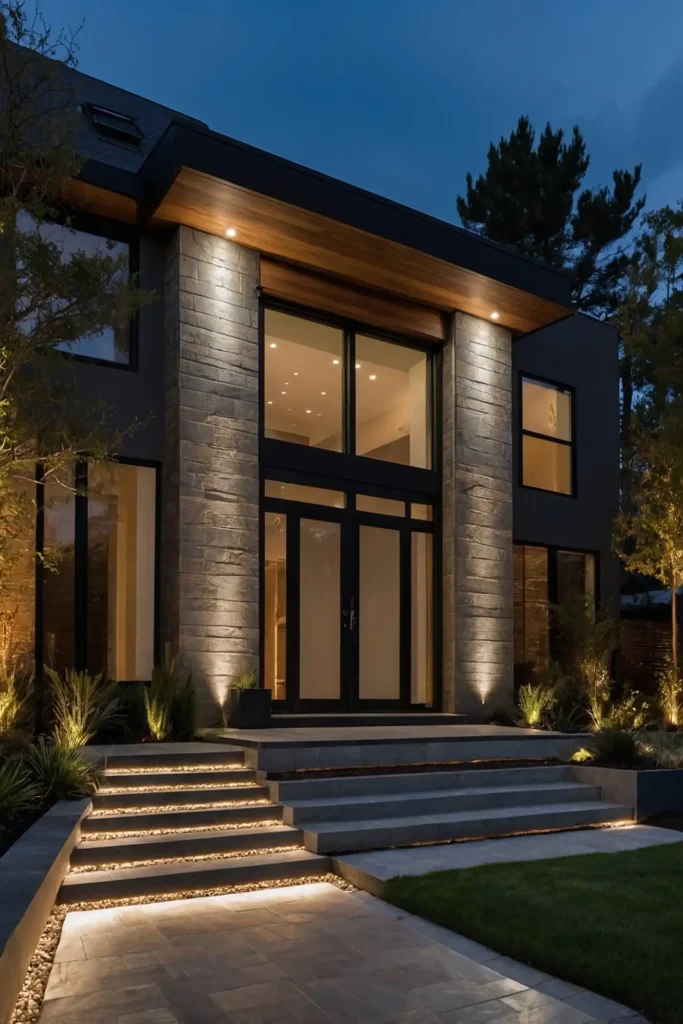
Direct focused beams of light on specific architectural elements or landscape features using sleek, unobtrusive spotlights.
Modern versions feature minimal housings that disappear into the landscape.
You’ll highlight your home’s best features while maintaining a clean, contemporary aesthetic.
Adjust beam angles and brightness to achieve precisely the effect you want without light spillage.
Choose fixtures in finishes that blend with surroundings—black disappears at night, while bronze integrates with landscaping.
21: Create Dramatic Façade Washes
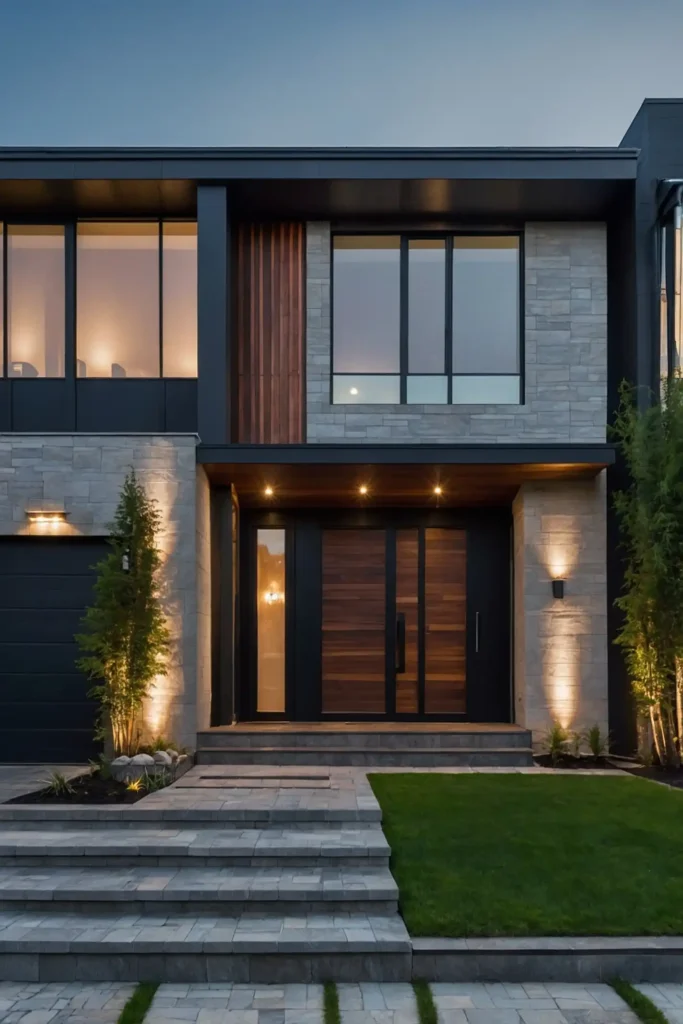
Install wide-beam floodlights positioned far enough from your home to evenly illuminate the entire façade.
This technique transforms your home’s appearance after dark through broad, even illumination.
You’ll showcase your home’s overall architecture rather than just specific details.
Position fixtures carefully to avoid glare into windows or neighboring properties.
Consider gentle cross-lighting from multiple directions to reduce harsh shadows and create more nuanced illumination.
22: Incorporate Illuminated House Numbers
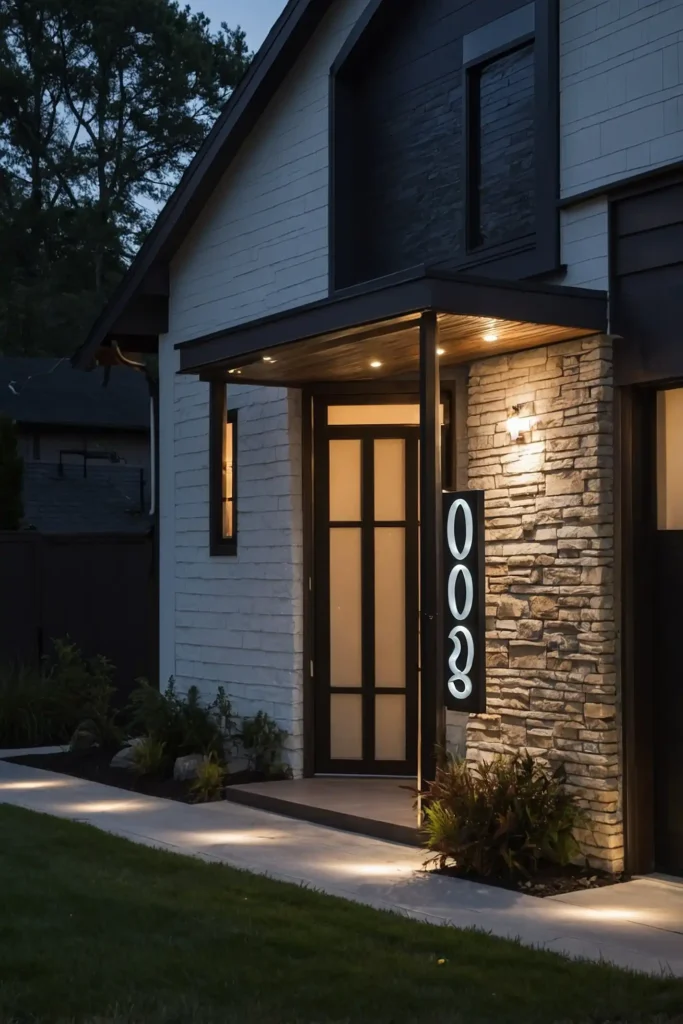
Install modern house numbers with integrated backlighting that provides both functional identification and architectural accent lighting.
These dual-purpose fixtures combine practicality with style.
You’ll improve visitor navigation while adding a sophisticated lighting element that enhances your entryway.
Choose contemporary fonts and materials that complement your home’s architectural style.
Consider solar-powered options for energy efficiency and simpler installation without electrical wiring.
23: Use Recessed Door Surround Lighting
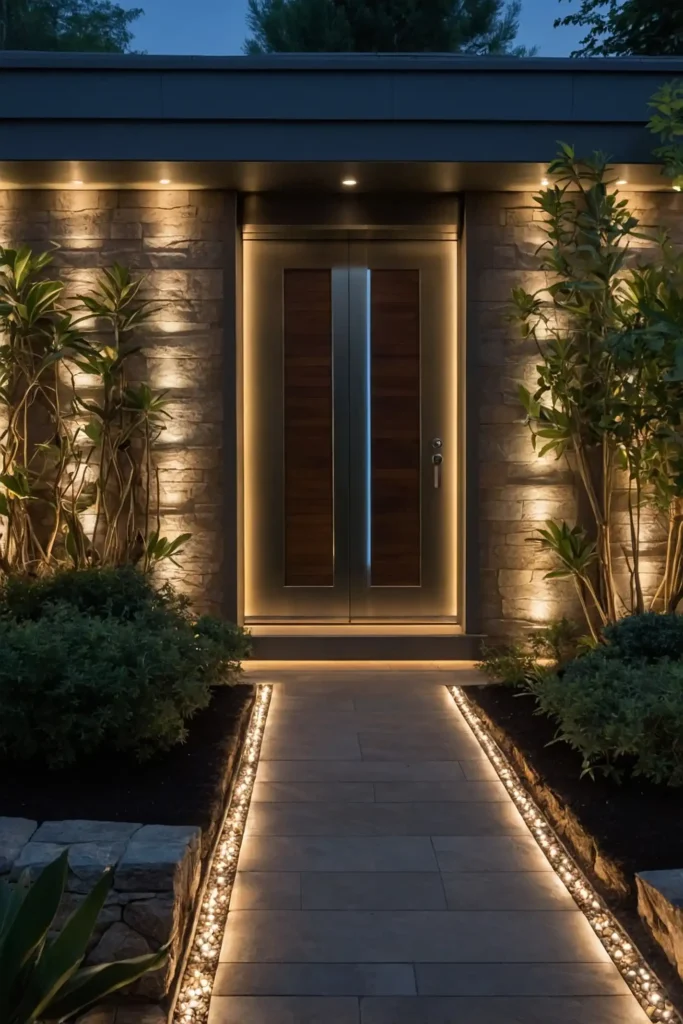
Install hidden lighting within door surrounds or entryway overhangs to create a glowing portal effect.
This architectural approach frames your entrance with light while concealing the source.
You’ll create a welcoming entry that draws visitors toward your door naturally.
Position the lighting to avoid glare when the door opens and closes for optimal functionality.
Consider motion sensors to increase illumination when someone approaches for both security and energy efficiency.
24: Add Vertical Garden Wall Lighting
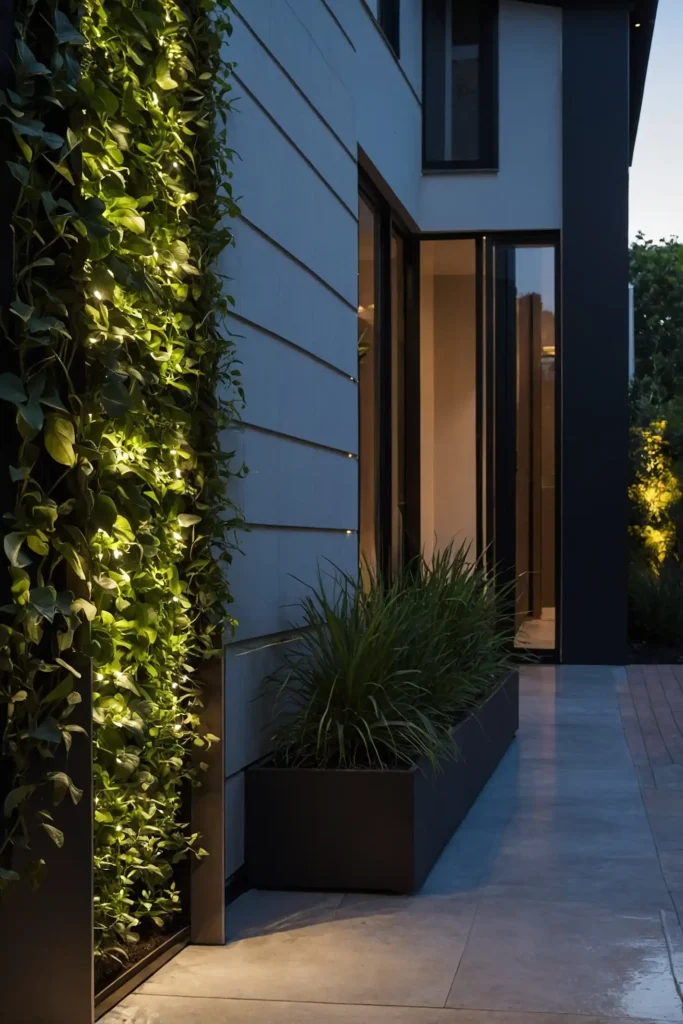
Illuminate living walls or vertical gardens with specially positioned lights that highlight the varied textures and colors of the plants.
This green feature becomes even more dramatic after dark.
You’ll create a stunning focal point that combines landscaping and lighting for maximum impact.
Choose lighting positions that avoid creating harsh shadows or flattening the dimensional quality of the plants.
Consider subtle color-shifting lights that enhance different foliage colors throughout the seasons.
25: Install Cove Lighting Under Roof Edges
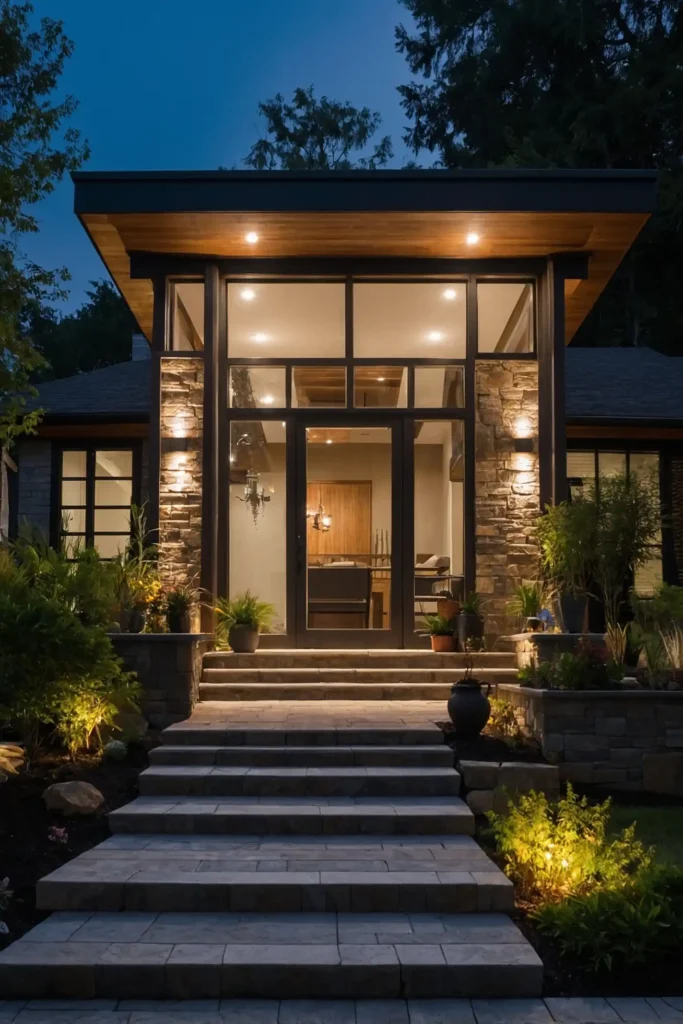
Place linear lighting in protected areas underneath roof edges or within architectural coves to create a glowing outline of your home’s roofline.
This technique emphasizes your home’s silhouette.
You’ll highlight architectural forms while adding a layer of ambient light that enhances overall exterior visibility.
Use high-quality, weather-resistant LED strips designed specifically for exterior applications.
Install with proper diffusers to ensure an even, continuous line of light without visible hot spots.
26: Create Water Feature Lighting
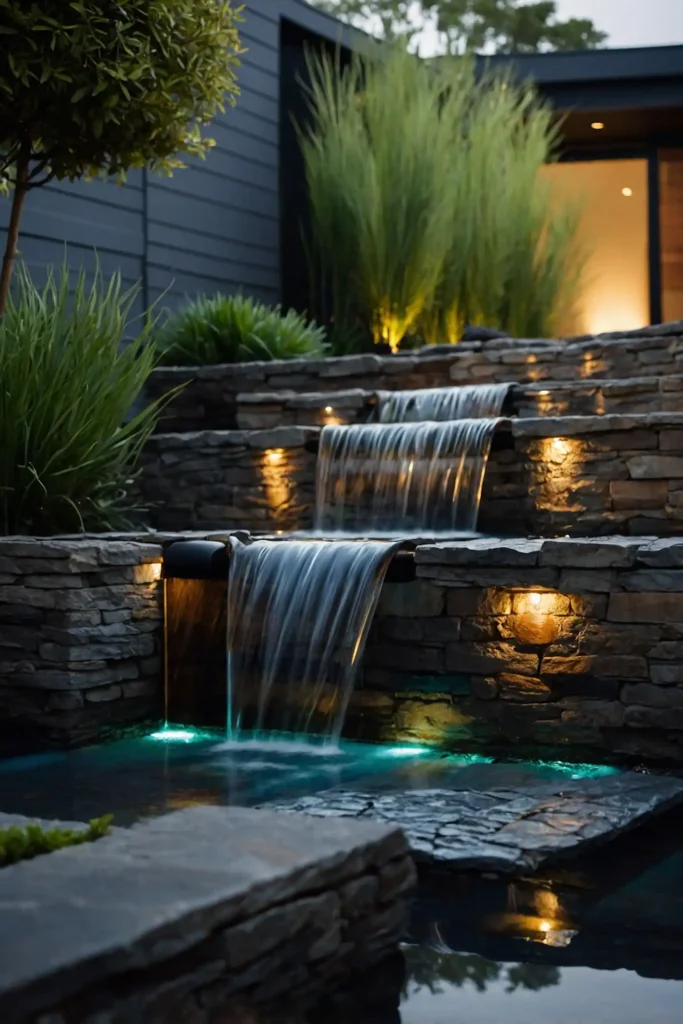
Illuminate fountains, reflecting pools, or other water features with submersible or adjacent lighting that captures the movement and reflective qualities of water.
These dynamic light effects create visual interest.
You’ll enhance the sensory experience of water elements, making them focal points after dark.
Consider fixtures with adjustable color options to transform the water’s appearance for different occasions.
Ensure all electrical components are properly rated for water proximity with appropriate safety systems.
27: Add Subtle Fence or Wall Grazing
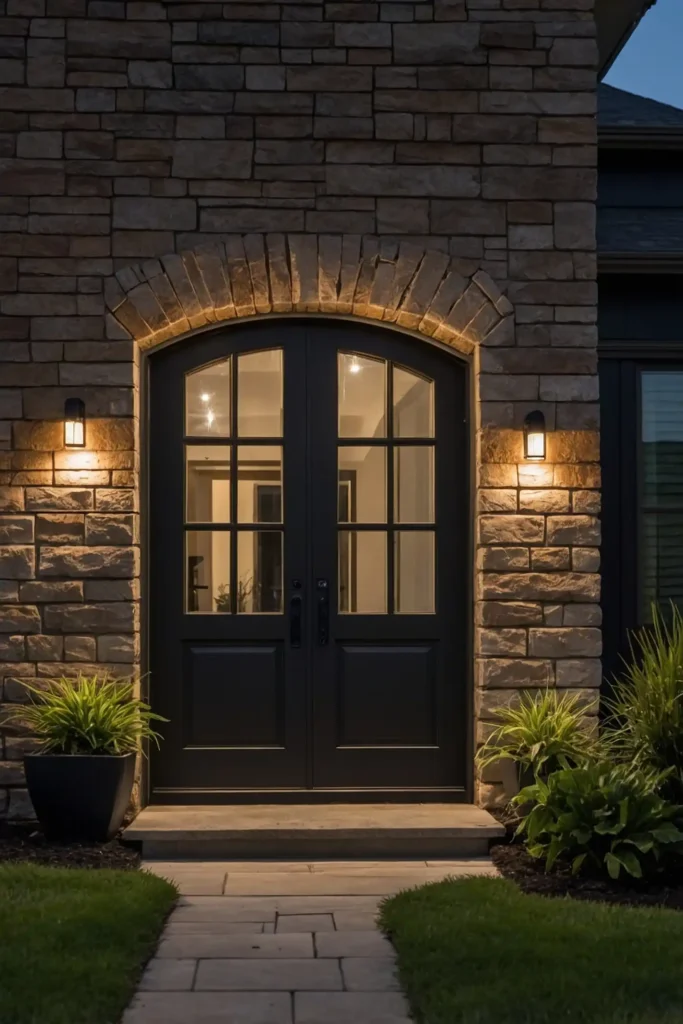
Install small, directional lights along the base of property walls or fences to wash these boundaries with gentle illumination.
This perimeter lighting defines your property while adding depth.
You’ll enhance security while creating a more defined sense of space after dark.
Position fixtures to highlight interesting textures or materials in boundary structures.
Space fixtures consistently to create uniform illumination without obvious bright and dark patches.
Conclusion
Modern front-of-house lighting transforms your home’s curb appeal while enhancing safety and security.
By combining different lighting techniques from this list, you’ll create a thoughtfully illuminated exterior that impresses guests and welcomes you home every evening.


